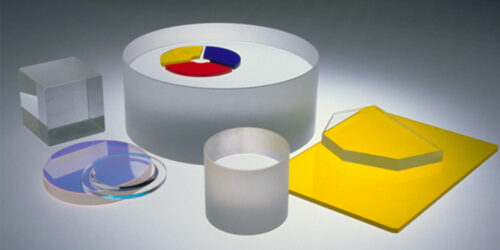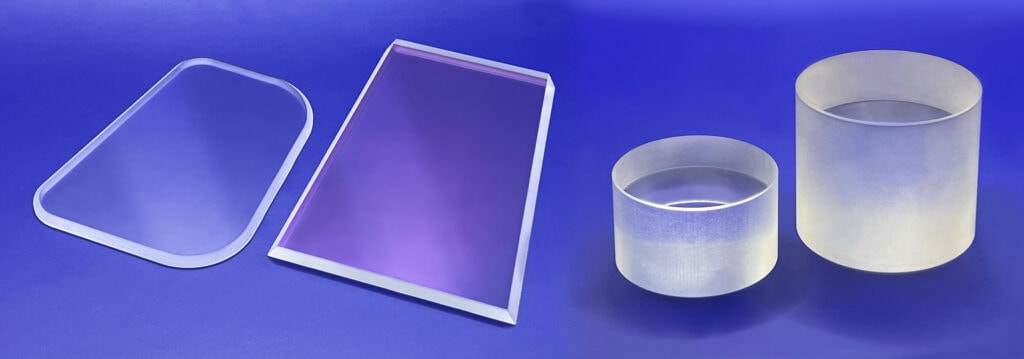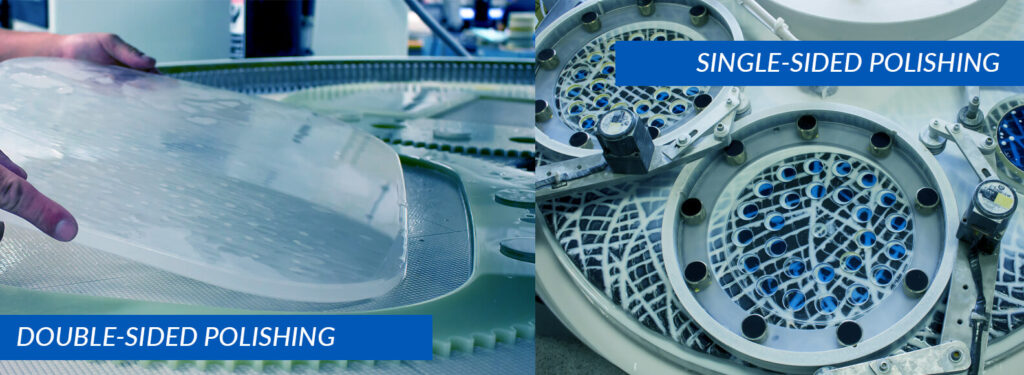
Flat components are available in a variety of shapes and sizes. From diameters to rectangles, squares, cubes and prisms, Sydor Optics can offer price and delivery based on your individual specifications. There are some areas that we require detailed information from our customers in order to provide them with the most accurate quotation. In this article we explain in more detail some of the requirements you should consider for your submission of a request for quote.
Material
Sydor Optics works with virtually all kinds of optical glass and many crystal materials. Some materials are easier to work with than others. Keep in mind the following material attributes that can impact the price to fabricate.
- Hardness – Material that is either too hard or too soft can be difficult to process. Examples of ideal materials to grind and polish are Fused Silica, BK7, Borofloat, and B270. CaF2 crystal material is very brittle material and necessitates extra care in handling. Sapphire, on the other hand, is one of the hardest materials and requires lengthy processing cycles.
- Stain – Some materials tend to stain. Glass with an SR (acid resistance) of 4 or higher is more difficult to work with.
- Heat/Humidity – Materials that are sensitive to heat and humidity may require special handling or humidity-controlled environments.

SHAPES
Flat optics are manufactured in many different sizes and shapes. Sydor Optics specializes in double-side grinding and polishing, the ideal process for windows, wafers, mirrors, etc. Thicker parts may necessitate processing via single-side process. One surface is processed at a time and usually is a more labor-intensive means of fabrication.
- Part geometry and size are the most basic variables.
- Parts can be square, rectangular, trapezoidal, round, elliptical or polygonal.
- Round parts process more uniformly than square or rectangular parts because they can rotate around their own axis.
- Thickness limitations are also lower with round parts.

CONSIDERATIONS
Dimensional Tolerances
It is helpful to know dimensional tolerances for such attributes as follows:
- Diameter
- Length
- Width
Thickness
Sydor’s default tolerances are +/-0.10mm or +/-0.005” on dimensional measurements
Aspect Ratio
Aspect ratio is the ratio of the part’s largest dimension (diameter or diagonal) to the thickness.
The higher the aspect ratio, the higher the probability that the glass will distort or become damaged during processing.
Parallelism
Sydor’s double-side grinding and polishing process yields precision parallel parts by removing material from the top and bottom simultaneously.
Parallelism is measured in degrees, minute and seconds or in thickness (one side to the other).
Surface Flatness (used for reflection)
Surface flatness is simply surface accuracy with respect to a plane reference surface.
Surface Flatness is used extensively in mirror specifications to obtain a good reflective image.
Transmitted Wavefront Error (used for transmission)
This specification is referred to in terms of “waves” and is measured on an interferometer to determine how light passes through a transparent medium. Transmitted Wavefront is commonly specified for windows and wafers.
Clear Aperture (CA)
The Clear Aperture is the “usable” area of an optic. This is usually a circular area and is specified by a diameter measurement or a percentage of the entire optical surface. It can also be referred to as Free Aperture.
Surface Quality
The optics industry has adopted the military specification MIL-0-13830A as the most commonly used standard for a rating of surface imperfections. The imperfections are specified as scratches and digs by the typical designation of “80-50”, “60-40”, or “40-20”. The two numbers refer to graded sets of surface quality standards. The number before the hyphen is the scratch number and the second number after the hyphen is the dig number:
A surface quality of 80-50 is considered “commercial quality” whereas a surface quality of 10-5 is utilized for high-end laser applications. The tighter the surface quality specified, the more expensive the optic is to fabricate.
Polishing Processes

When fabricating flat-surface optics, there are several types of approaches to processing.
- Double-Side Polishing
- Double-sided grinding and polishing utilizes planetary action with the flat optics polishing combination of a top and bottom plate to precisely grind and polish precision, parallel optics
- Optics fabricated by this process are run in “batches”
- There are economical batch sizes that are determined by the size of the optic and the machine that is selected to process the parts
- As a rule of thumb, the higher the quantity, the lower the price
- Conventional or Single-Side Polishing
- Optics fabricated by this process are fabricated one side at a time
- This is a more time-consuming process as compared to double-side polishing
- Frequently utilized for optics for which one side is ground and one side is polished
- Pitch Polishing
- Pitch polishing process is utilized for requirements specifying fractional wave surface flatness
- Pitch polishing is based upon the premise of single-side polishing whereas only one surface is processed at a time
Quantity
Pricing is usually sensitive to the quantity being processed. For the most part, the smaller the quantity, the higher the price and vice versa.
Lot Charges – Sydor may offer a “lot charge” for a batch of components because the requested quantity is too small for us to process
Double-Side Processing – The double-side process requires the use of batch processing. Sydor may offer an economical quantity as an alternative for your consideration
Submit Your Detailed Quote Request Today
Sydor Optics will be better prepared to provide you with an accurate quotation if the above specifications have been detailed in the early stages of quote preparation. Sales Engineers are available to provide assistance in understanding any of the optical / mechanical specifications.
Link to Specify Custom Optics page






